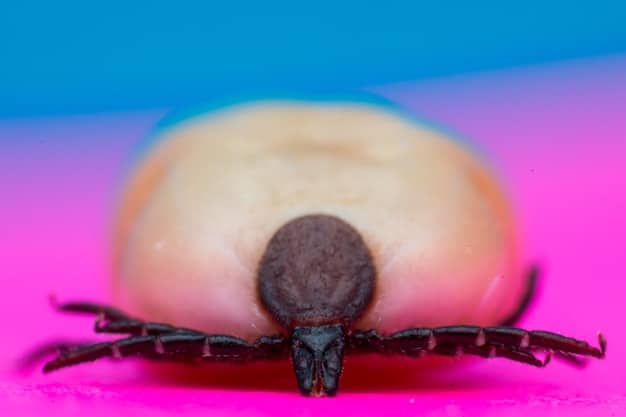Top Flea and Tick Prevention: 2025 Reviews & Safety Tips

Top-rated flea and tick prevention products for 2025 include a variety of options, from topical treatments and oral medications to collars, ensuring pet owners can find a safe and effective solution tailored to their pet’s needs and lifestyle.
Protecting our beloved pets from fleas and ticks is a top priority for any responsible owner. As we look ahead to 2025, let’s explore the top-rated flea and tick prevention products, ensuring your furry friend stays healthy, happy, and pest-free.
Understanding Flea and Tick Threats to Pets
Fleas and ticks are more than just a nuisance; they pose significant health risks to our pets. Understanding these risks is the first step in choosing the right preventative measures.
Health Risks Associated with Fleas
Fleas can cause intense itching and discomfort, leading to excessive scratching and potential skin infections. In severe cases, fleas can cause anemia, especially in young or small animals. Fleas can also transmit tapeworms, which can further compromise your pet’s health.
Health Risks Associated with Ticks
Ticks are notorious for transmitting various diseases, including Lyme disease, Ehrlichiosis, and Rocky Mountain spotted fever. These diseases can cause serious health problems and even be life-threatening. Ticks attach themselves to pets and feed on their blood, making regular checks and preventative measures crucial.
Early detection and prevention are key to safeguarding your pet’s health. Regular grooming and thorough examinations can help identify fleas and ticks before they cause significant problems. Choosing the right flea and tick prevention product can provide continuous protection, allowing your pet to enjoy the outdoors without the constant threat of these pests.

Top Flea and Tick Prevention Methods
Numerous methods are available for preventing fleas and ticks, each with its advantages and disadvantages. Choosing the best method depends on your pet’s lifestyle, breed, and any existing health conditions.
Topical Treatments
Topical treatments are applied directly to your pet’s skin, usually between the shoulder blades to prevent licking. These treatments often contain ingredients that kill fleas and ticks on contact or are absorbed into the pet’s bloodstream for ongoing protection. Advantages include ease of application and broad-spectrum protection. Disadvantages can include skin irritation in some pets and the need to reapply after bathing.
Oral Medications
Oral medications are given to pets by mouth and work by entering the bloodstream. When fleas and ticks bite a treated pet, they ingest the medication and die. Oral medications are often highly effective and provide long-lasting protection. However, some pets may experience side effects, such as vomiting or diarrhea.
- Topical Treatments: Applied to the skin, easy to use.
- Oral Medications: Taken by mouth, effective and long-lasting.
- Flea and Tick Collars: Provides continuous release of medication.
- Shampoos and Dips: Used during bathing, offer immediate relief.
Understanding the different prevention methods available allows you to make an informed decision about the best approach for your pet. Consulting with your veterinarian can provide personalized recommendations based on your pet’s specific needs and health status.
Exploring Top-Rated Flea and Tick Products for 2025
In 2025, several flea and tick prevention products stand out for their effectiveness and safety. These products have undergone rigorous testing and are trusted by veterinarians and pet owners alike.
Frontline Plus
Frontline Plus is a topical treatment that kills fleas, ticks, and chewing lice. It contains fipronil and (S)-methoprene, which work together to kill adult fleas and prevent flea eggs and larvae from developing. Frontline Plus is waterproof and provides month-long protection.
NexGard
NexGard is an oral medication that kills fleas and ticks. It contains afoxolaner, which works by disrupting the nervous system of fleas and ticks. NexGard is given once a month and is safe for dogs and puppies eight weeks of age or older.
Seresto Collar
The Seresto Collar provides up to eight months of continuous protection against fleas and ticks. It contains imidacloprid and flumethrin, which are released slowly over time. The collar is odorless, non-greasy, and water-resistant.
Choosing the right product involves considering factors such as your pet’s age, weight, breed, and any existing health conditions. It’s important to read product labels carefully and follow the instructions provided.
Safety Considerations for Prevention Products
Safety is a paramount concern when choosing flea and tick prevention products. Understanding the potential side effects and contraindications is crucial for protecting your pet’s health.
Potential Side Effects
Some flea and tick prevention products can cause side effects, such as skin irritation, vomiting, diarrhea, and lethargy. It’s essential to monitor your pet closely after applying or administering any new product. If you notice any adverse reactions, contact your veterinarian immediately.
Contraindications and Precautions
Certain products may be contraindicated for pets with specific health conditions, such as liver or kidney disease. Pregnant or nursing animals may also require special considerations. Always consult with your veterinarian before using any new flea and tick prevention product.
- Read Labels Carefully: Understand the ingredients and instructions.
- Consult Your Veterinarian: Get personalized recommendations.
- Monitor for Side Effects: Watch for any adverse reactions.
- Store Products Safely: Keep out of reach of children and pets.
By prioritizing safety and taking necessary precautions, you can minimize the risk of adverse reactions and ensure that your pet receives the protection they need.

Natural and Alternative Prevention Strategies
For pet owners seeking alternatives to conventional flea and tick prevention products, several natural options are available. While these methods may not be as effective as traditional treatments, they can be a suitable option for pets with sensitivities or mild infestations.
Essential Oils
Certain essential oils, such as lavender, cedarwood, and eucalyptus, are known for their insect-repellent properties. These oils can be diluted and applied to your pet’s coat, or used in a diffuser to create a pest-repelling environment. However, it’s essential to use essential oils with caution, as some can be toxic to pets.
Diatomaceous Earth
Diatomaceous earth (DE) is a natural powder made from fossilized algae. It works by dehydrating insects, causing them to die. DE can be sprinkled around your home and yard to help control flea and tick populations. However, it’s important to use food-grade DE, as other types can be harmful to pets.
Natural prevention strategies can be a complementary approach to conventional treatments. Combining natural methods with regular grooming and environmental control can help minimize the risk of flea and tick infestations. Always consult with your veterinarian before implementing any new prevention strategy.
Creating a Pest-Free Environment
Preventing flea and tick infestations involves more than just treating your pet; it also requires creating a pest-free environment in your home and yard. Taking proactive steps to control flea and tick populations can significantly reduce the risk of infestation.
Regular Cleaning
Regular vacuuming and cleaning can help remove flea eggs, larvae, and pupae from your home. Pay special attention to areas where your pet spends the most time, such as carpets, bedding, and furniture. Washing your pet’s bedding regularly in hot water can also help kill fleas and ticks.
Yard Maintenance
Keeping your yard well-maintained can help reduce flea and tick populations. Mow your lawn regularly, trim shrubs and trees, and remove leaf litter and debris. These measures can help eliminate breeding grounds for fleas and ticks. Consider using pet-safe insecticides or nematodes to control pests in your yard.
Controlling flea and tick populations in your home and yard is an ongoing process. By combining preventive measures with regular cleaning and maintenance, you can create a pest-free environment for your pet and your family.
| Key Point | Brief Description |
|---|---|
| 🐶Choosing a Prevention Method | Consider topical, oral, or collar treatments. Best fit for lifestyle. |
| 🛡️ Safety First | Read labels and consult your vet for safe product choices. |
| 🌿 Environment Control | Clean homes and yards maintain health for pets. |
| 🐾 Regular Checks | Continually observe for and remove fleas and ticks during grooming. |
FAQ
▼
Signs of flea and tick infestation include excessive scratching, biting at the skin, visible fleas or ticks, and red or irritated skin. Checking regularly helps in early detection.
▼
The frequency of application depends on the product. Topical treatments are usually applied monthly, while some collars provide protection for several months. Always follow the product label.
▼
No, human flea and tick products are not safe for pets. They often contain ingredients that can be toxic to animals. Always use products specifically designed for pets.
▼
Some natural remedies include essential oils and diatomaceous earth. However, their effectiveness may vary. Consult with your veterinarian before using natural remedies, to ensure pet health.
▼
Regular cleaning, vacuuming, and washing pet bedding can help prevent flea infestations in your home. Focus these efforts on the areas where pests are most likely to breed.
Conclusion
Choosing the right flea and tick prevention product is a crucial part of responsible pet ownership. By understanding the threats posed by these pests, exploring the top-rated products for 2025, and prioritizing safety, you can ensure your furry friend stays healthy and happy. Remember to consult with your veterinarian to determine the best approach for your pet’s specific needs.





